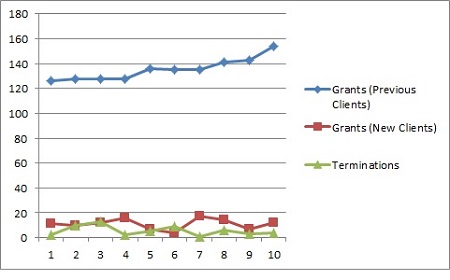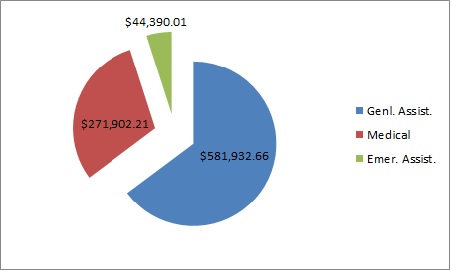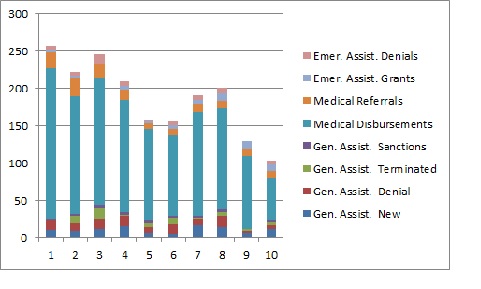CSNA 2014 Annual Meeting & Township Forum Report
Betty Sue Ester (Left - AGAINST) and Larry Suffredin (Center - FOR) are introduced by CSNA President John Walsh (Right) as they prepare to debate the upcoming referendum to abolish the Township.
Central Street Neighbors Association held its 2014 Annual Meeting Wednesday, February 19. Six judicial candidates for seats on the Cook County 9th Sub-Circuit were introduced and were available to talk about their candidacies with residents. Those present included:
For the Goldberg vacancy:
- Jerry A. Esrig of Evanston
For the Myer vacancy:
- Anjana Hansen of Evanston
For the Preston vacancy:
- Michael Francis Otto
- Abbey Fishman Romanek of Wilmette
- Michael Allen Strom
- Brian Alexander of Skokie
During the business meeting two new members, Connie Heneghan and Lee Rogulich, were elected to the board. Returning board members included Jim Hughes, and David Staub. Returning Officers include John Walsh and Jeff Smith President and Vice President respectively. The new 2014 board is here.
Forum Report
(for the full article with the Forum Report click here)
Following the business meeting an hour long forum was held on the March 18 binding referendum issue to abolish the separate Evanston Township and combine its functions with the Evanston city government.
Shall the township organization be discontinued and abolished in Evanston Township?
Larry Suffredin, Cook County Commisioner for the 13th District spoke for the resolution. Betty Sue Ester, longtime Evanston community activist, spoke against. Approximately 48 attended including judicial candidates, CSNA members, the speakers and members of the public. The question-and-answer period brought spirited discussion among those present and on the podium.
Information about the referendum brought up at the meeting included:
- 182 people are currently on General Assistance. Betty Sue Ester expressed concern about continuity of service to those currently served. Larry Suffredin felt that the need was greater than those currently served and the City goal should be to meet the larger need. . One noted difference was that the Township is not under home rule and their levy authority is capped. Under the city home rule laws the levy would not be capped. Speakers from the audience questioned Evanston's commitment to those in need going forward and specifically how the General Assistance program would fare given the competing budget issues facing the City.
- Betty Sue Ester pointed out that the current number on General Assistance does not reflect the additional number that come and go during any one month.
- Assistance of up to $500 per month is available. Larry Suffredin pointed out that the current city aldermen also act as Township Trustees and they approved that amount so it should not change.
- All agreed that this issue has been discussed over a long period and that the election itself faces an uphill battle in capturing citizen interest. Larry Suffredin pointed to a forecast of 12% turnout for the county.
News articles covering the forum:
Township referendum resources:
- League of Women Voters Evanston Township Fact Sheet
- City response to LWV questions Oct. 22, 2013
- Evanston Township website
- 2014 Township Budget
- 2013 Township Activity Reports (10 Mos. from Jan. - Oct.)
The city produced a 10 month System Activity Report for the Township covering January, 2013 to October, 2013. It is published on the city website (link above). The data contained reveal some of the inner workings of the department and could serve as a benchmark for management of the program. One caution is that long term trends should not be inferred from 10 months of data. Some highlights from these data are presented here for future comparison.
 Figure 1. General Assistance (GA) clients receive monthly disbursements for housing (up to $200) and personal needs (up to $300). Clients are added (New) and leave (Terminations) the program monthly. The majority of clients (Previous) continue to the next month. The number of clients was growing during the 10 month period. As of December, 2013 there were 182 clients on GA.
Figure 1. General Assistance (GA) clients receive monthly disbursements for housing (up to $200) and personal needs (up to $300). Clients are added (New) and leave (Terminations) the program monthly. The majority of clients (Previous) continue to the next month. The number of clients was growing during the 10 month period. As of December, 2013 there were 182 clients on GA.
 Figure 2. General Assistance and Medical Assistance for the period are 65% and 30% of program expense respectively.
Figure 2. General Assistance and Medical Assistance for the period are 65% and 30% of program expense respectively.
 Figure 3. Monthly activity measured by the number of types of program case events reported for the period shows a decline. Medical disbursements make up the greatest share of activity, but this may not relate to actual work effort.
Figure 3. Monthly activity measured by the number of types of program case events reported for the period shows a decline. Medical disbursements make up the greatest share of activity, but this may not relate to actual work effort.
 Figure 4. The total monthly disbursements divided by the total monthly clients yields the average monthly disbursement by case type. Emergency Assistance is a typical one-time benefit and is the largest on a per client basis at $800. Per the 2014 Budget the majority (90%) of that is for housing. General Assistance clients receive benefits over a longer period of time. A little less than half goes for housing. Approximately two-thirds of Medical Disbursements goes for medications ... again according to the 2013 actuals in the 2014 budget.
Figure 4. The total monthly disbursements divided by the total monthly clients yields the average monthly disbursement by case type. Emergency Assistance is a typical one-time benefit and is the largest on a per client basis at $800. Per the 2014 Budget the majority (90%) of that is for housing. General Assistance clients receive benefits over a longer period of time. A little less than half goes for housing. Approximately two-thirds of Medical Disbursements goes for medications ... again according to the 2013 actuals in the 2014 budget.
(The above report is based on my notes and analysis and does not reflect any position of Central Street Neighbors Association - Jim Hughes)
- Jim Hughes's blog
- Log in to post comments
